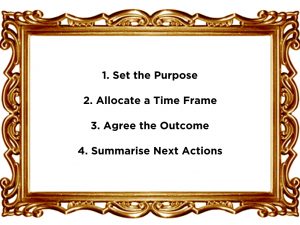
I believe that the foundation of effective business is all about productive conversations. As a leader, or indeed as an employee, you add value to your role, your organisation and your Clients by having communication expertise.
Following on from the article on which hat you’re wearing in a conversation, we’re now looking at the 4 key ways to frame a conversation – that makes it effective for both parties involved. We’re building on the hat analogy, and topping up with three further areas to frame a conversation to build your toolkit for productive conversations in the workplace. Don’t forget, these principles can be applied to how to have a productive conversation with your spouse too.
How many times you’re interrupted in a day?
Someone physically popping by your desk, by a call you chose to take, by that ding of a new email, falling into a rabbit hole of internet searching yourself (and even going to indecisive or unguided meetings). Experts say it an average of 15 seconds – 23 minutes to refocus on what you were doing after being interrupted. If we add these up we’re losing at least one productive hour each day that compounds over the week.
How many times people don’t know ‘why’ they are coming to speak to you?
An interesting observation of mine from working in many an office, do you often find people disturb you by doing a U-turn by your desk, “oh, just coming over here helped me solve it in my own mind – thanks” and walk away and you feel a little dumfounded or irritated that they shifted your focus away from what you were working on. I’m certain there are countless other examples of people using up precious time without having purpose.
Framing a conversation can be instrumental in changing your communication effectiveness – both ways. Actually stating your intention before launching into the point, sets the tone and outcome of the discussion.
Here are four simple ways to frame a conversation, or ask people to approach you in the future:
- Set the Purpose: why do they/ you want your consult with one another? This goes back to the ‘hat’ you’re wearing. Is it for advice, to bounce an idea, banter about a project or customer, to kill some time. Be clear on why you’re in the conversation with others.
- Allocate a time frame; how much of your time and energy do they need? I’ve found this point alone to be transformative. There is something tidy about agreeing with someone that they can have 5/10/15 minutes of your time that gets them (and you) to the point and solution MUCH quicker.
- Agree the outcome; what is the solution required? It is different to the purpose, it is the specifics of ‘what’ is actually required. For example, feedback for a customer call, help with excel spreadsheet, advice on an email, decision on a budget…
- Summarise next actions; who is doing what by when and how? Again, notice how often do you leave a conversation without agreed actions in the workplace, or with your partner. End of play or end of the week, can mean many things to different people, set a deadline for when tasks will be completed before you end a chat with someone.
Here is an example to demonstrate the above 4 points, “Hey Jill, sorry to swing by unannounced, can I grab some time with you for 15 minutes before the end of the day, I need to get back to <customer X> with a solution to a dilemma the tech team are facing by 6pm, and I really need your advice on how to better word my response to both of the parties involved. I’d appreciate your feedback on what I’ve drafted to say on the phone to <customer X> and an email to the tech team.”
Experiment a little…
Take two minutes to structure your next conversation with your boss/ peer/ direct report using this structure. Think about how you can frame conversations differently – and effectively.
Using this 4-step approach to framing your communication will make your conversations valuable, relationships better, way of doing business more effective – contact me here for more information on how we could work together.

Comments +